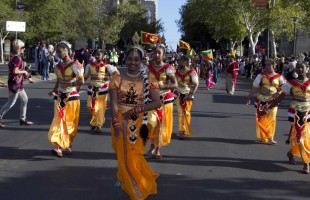A fortunate combination of climate and geomorphology has produced several different forms of forest, each with its distinctive plants, animals and birds, not to mention waterlife. For hundreds of years, travellers have marvelled at the preponderance of the many shades of green wherever they cast their eyes. Not to be outdone however, flowers vie with foliage, especially during the spring months of March to May, when trees and shrubs explode into a riot of incredible colour.
South west wet zone
This is an area of tropical rainforest and receives the maximum rainfall. It is characterised by dense undergrowth with a canopy of tall hardwood trees including teak, ebony and silkwood. Some of the most beautiful orchids can also be found here as well as most of the plants used in Ayurveda or traditional healing.
The Zone includes the Sinharaja Forest, the last remaining patch of virgin rainforest. It is the richest in endemic flora and fauna and said to have had over 120 species of trees alone. Vital to the eco-system and still majestic, the forest wilderness has been much reduced due to illicit clearing. It is now a Unesco World Heritage Site.
This is defined as the cool, damp highland region in the south central part of the island. Two distictive steps elevate the low lying plains first into the middle plain of this region and then into the highest central mountain ranges.
Low country rainforests and cultivations of paddy gradually change into mantles of intermediate foothill forests such as the Udawattekele Sanctuary in Kandy. Surprisingly close to town, this quiet and enchanting forest reserve has also fallen victim to encroaching construction and shrunk considerably. There are also exotic trees which had been introduced later including pine, spruce, eucalyptus and deodar, seen in the central foothill forests around the tea plantations.
The high altitude montane forests emerge from intermediate forests. Distinguishing these from the former are the distinctive hardy grasslands or patanas, patches of stunted trees and shrubs covered in Spanish moss and rhododendrons, more reminiscent of an English moor than a tropical island. The best examples of this form of forest are the Forest Reserves of Horton Plains, Adam’s Peak Wilderness and other areas around Nuwera Eliya.
Dry Zone
The remainder of the island falls into this category of vegetation. It includes the north central, north western, eastern and parts of the southern provinces. All the major wildlife reserves are to be found in this zone, including Yala.
Most of the land is covered in sparse, dry scrub jungle. Forests are ususally open with an undergrowth of grass and herbaceous cover. Towering over this mixed scrub is a patchy canopy of huge evergreen and shady trees. Ebony, satinwood and “maara” can often be found in these forests. Occasional riverine forests meander through this harsh landscape with their own species of trees
Coastal vegetation
includes many different plants. Where exposed to winds, trees grow in prone positions with branches spreading out horizontally.
Gardens
Apart from the natural verdure, there are several gardens and parks. The tradition of cultivating land for aesthetic purposes goes back more than 2000 years to the time of the ancient kings. The ruins at Anuradhapura and subsequent royal cities have left remnants of grounds that are among the earliest and best landscaped in Asia. The more recent parks make rewarding walks not only for the plant lover but also for the bird enthusiast. The main parks are:
The Royal Botanic Gardens at Peradeniya
The Gardens date back to the Kandyan kingdom, when they were used as royal pleasure grounds. However, it was soon after the British seized the Kandyan Kingdom that they were established in 1821. The Gardens are elegantly landscaped over 150 hectares of beautifully undulating grounds. Within this large loop of the meandering Mahaweli Ganga is a spectacular display of more than 400 species of indigenous tropical flora and exotic plants.
Hakkgala Botanic Gardens
near Nuwera Eliya was established in 1861 at an elevation of 1700m . Its splendid collection of subtropical plants with many that thrive in temperate climes are well worth seeing. An added fillip is the probability of sightings of large bear monkeys and the stunning blue magpies from the adjoining Hakkgala Reserve.
Henarathgoda Botanic Gardens
About 30 km from Colombo at Gampaha, is a low country Park opened in 1876. There is a very interesting and varied collection of plants, including the very first rubber tree introduced to the island and grown from seeds smuggled out of Brazil.
Viharamahadevi Park
This is the largest of several parks in Colombo. It is the last remnant of the cinnamon plantations that covered adjacent land, giving the residential area of Cinnamon Gardens its name. The park is a wonderful sight from March to May, when its trees burst into flower. You can see ebony, mahogany, fig, lemon and the last cinnamon trees from the plantations established over a hundred years ago. Tethered in the shade and swaying to and fro in one corner of the park may be elephants, sometimes parked here for the night. During peraheras held at nearby temples, up to fifty or so elephants may be accommodated here for about a week.



